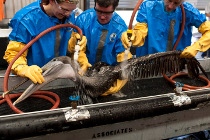Birdlife threatened in Gulf of Mexico
Now that the oil has hit Louisiana's coastal islands the environmental damage could be catastrophic.

 A Northern Gannet seabird was the first victim of the oil spill in the Gulf of Mexico, but this was only the beginning of a long chain of events sparked by the spill. It can take years for the damage from an oil spill to diminish and the pressure on species', habitats and ecosystems in that time can be devastating. Now that the oil has hit Louisiana's coastal islands the environmental damage could be catastrophic.
A Northern Gannet seabird was the first victim of the oil spill in the Gulf of Mexico, but this was only the beginning of a long chain of events sparked by the spill. It can take years for the damage from an oil spill to diminish and the pressure on species', habitats and ecosystems in that time can be devastating. Now that the oil has hit Louisiana's coastal islands the environmental damage could be catastrophic.
The risk to waterfowl is high, as without human intervention infected birds will die. The oil makes it difficult for a bird to fly or swim and seriously affects their insulation as their feathers become stuck together leaving their skin exposed. If oil is swallowed or contaminated food is ingested it can damage a birds digestion system.
Louisiana's state bird, the Brown Pelican, is currently in the middle of its nesting season. It nests on the barrier islands and feeds near the shore. There are concerns about its safety as the oil drifts further inland. The Brown Pelican was only removed from the United States Endangered Species act last November and if the slick hits the shore it could be detrimental to the species' growth and development. Now that the oil slick has hit the coastline it could spell environmental disaster for the breeding grounds in wildlife reserves, state and national parks.
The spill also coincides with the peak migratory period that passes through the Mississippi flyaway, a vital migratory corridor. Therefore a larger variety of birds will potentially be harmed and ecosystems in other locations could be affected. This may reduce the number of birds that complete their migratory journey affecting habitats further afield.
Strong winds are pushing the oil closer and closer to the coastline where booms have been constructed to help keep the oil at bay. If the oil settles in the mangroves and marshes the situation will dramatically worsen as the on land pollution can last for years. Oysters and shrimp that live in these wetlands will ingest the oil once these areas become infected. These filter feeders are a food source for water foul and their contamination would have consequences throughout the food chain. It is imperative for the ecosystems in the Gulf that the spill is halted as soon as possible and BP's clean up of the crude oil is quick and efficient in order to keep the environmental impact of the spill to a minimum.
The oil can reside for years once it has settled and therefore its impact on the biodiversity of an area is long lasting. After similar incidents such as the catastrophic Exxon Valdez Spill in 1989, which the Gulf spill is being compared to, reports of reductions in species population and higher death rates in the following years demonstrate that the potential for enduring damage is a danger. Even though the Exxon Valdez spill happened 21 years ago there are still reports of buried oil being found along the Alaskan coastline that is still having an impact on the local environment, which has never fully recovered.
Author: Rachael Bristow | Climate Action
Image: IBRRC | Flickr
